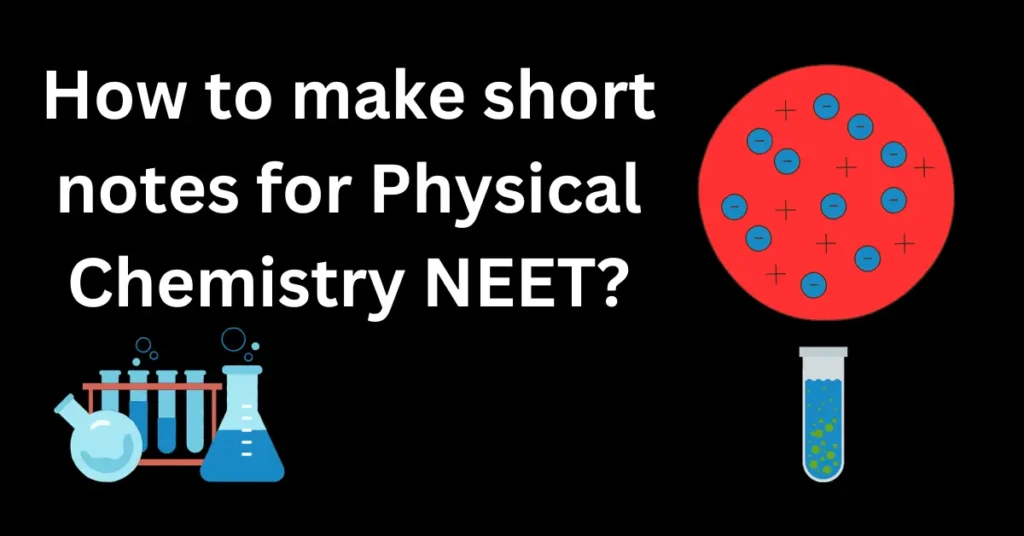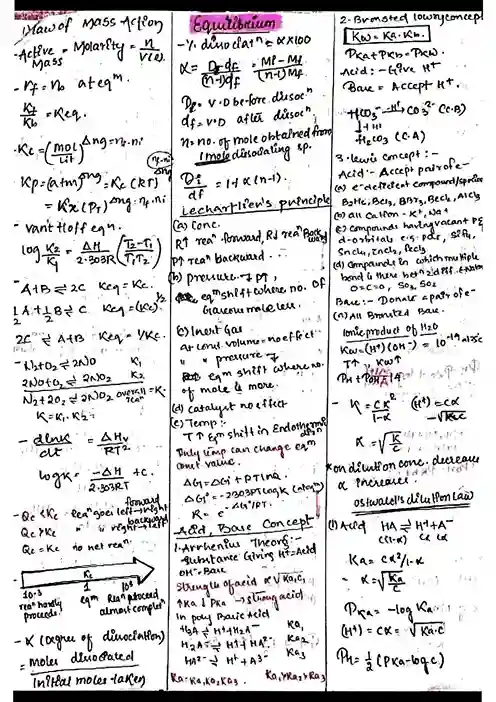
Making short notes is a highly effective strategy for the NEET exam preparation, and physical chemistry is no exception.
Unfortunately, many students don’t know how to make short notes for physical chemistry NEET. Candidates don’t know what to include and what to skip in their short notes.
If you are one of those students, you must stop worrying because this article will teach you what you should include and what you should skip in your physical chemistry short notes for NEET.
Also, you will know which study material you should use to prepare short notes, whether books, detailed notes, etc.
Read Also: How to make short notes for Organic Chemistry NEET?
Tools needed to make short notes for Physical Chemistry NEET
1. A4 size paper or good quality notebooks: You will need high-quality A4 size papers. Use notebooks if you don’t like writing on A4 size papers; just make sure the notes are of good quality.
2. Colored pens: With the help of colored pens, you can make your short notes more visually appealing.
3. Highlighters: Highlighters allow you to mark important key points of a topic. During revision, these highlighted points stand out.
Read Also: How to make short notes for Inorganic Chemistry NEET?
What you should include In Physical Chemistry short notes?
1. Some Basic Concepts of Chemistry
Briefly write about the mole concept, molar, atomic, and molecular mass. Include all the formulas of the topic mole concept, e.g., Number of Moles = (Mass of the Sample)/(Molar Mass). Also include constant values like Avogadro’s number.
2. Structure of Atom
Give an overview of the various atom models (Dalton, Thomson, Rutherford, Bohr). Explain terminologies like atomic number, isotopes, and isobar in bullet points.
Also, briefly explain quantum numbers, shapes of s, p, d & f orbitals, and various principles and rules like the Heisenberg uncertainty principle, Aufbau principle, Pauli exclusion principles, and Hund’s rule.
Read Also: How to make short notes for NEET Physics?
3. States of Matter: Gases and Liquids
Write briefly about the properties of the three states of matter (solid, liquid & gas). Briefly explain laws like Boyle’s Law, Charles’s Law, Gay Lussac’s Law, and Avogadro’s Law. Also, write the essential formulas and equations, e.g., PV = nRT.
4. Thermodynamics
Explain briefly the laws of thermodynamics (1st law, 2nd law & 3rd law) and Hess’s Law of Constant Heat. In bullet points, explain terminologies like enthalpy, entropy, Gibbs free energy, etc.
5. Equilibrium
Write briefly about equilibrium constants and laws like the law of chemical equilibrium. Also, write about factors affecting equilibrium – Le Chatelier’s principle, pH scale, buffer solution, ions, etc. Include important formulas, e.g., Kp = Kc (RT)Δn.
6. Redox Reactions
In summary, explain the concept of oxidation and reduction, oxidation number, types of redox reactions (Decomposition Reaction, Combination Reaction, Displacement Reaction, and Disproportionation Reaction), etc.
Also, write the steps to balance a redox reaction with appropriate examples; include both methods (oxidation state method and half-reaction method).
7. Solid State
Give an overview of the physical and chemical properties of solids as well as types of solid states (crystalline and amorphous solids) and their properties.
8. Solutions
Write in your short notes the types of solutions and explain colligative properties (lowering of vapor pressure, boiling point elevation, freezing point depression, and osmotic pressure ) briefly.
Also, describe Raoult’s Law, Van’t Hoff Factor, and molar mass determination.
9. Electrochemistry
Write in short the types of electrochemical cells (galvanic and electrolytic cells), conductivity, and Nernst equation. Also, briefly describe laws like Faraday’s Laws of Electrolysis, Kohlrausch law, etc.
10. Chemical Kinetics
Explain terminologies like rate of reaction, order of a reaction, and molecularity of a reaction briefly.
Also, describe Rate Law, First order reactions, Half-life of a reaction, Activation Energy, Collision Theory, Arrhenius equation, etc.
11. Surface Chemistry
Briefly describe adsorption and its types – physisorption and chemisorption. Also, write briefly about colloids, the Tyndall effect, catalysis, emulsions, etc.
Read Also: How to make short notes for Zoology NEET?
From where do you need to make NEET Physical Chemistry short notes?
1. Class Notes: From the detailed Physical Chemistry notes provided by your coaching institute or school, prepare short notes.
2. NCERT Books: Study a topic or chapter from NCERT Chemistry (Physical Chemistry section) and prepare short notes.
Read Also: How to make notes from NCERT for NEET?
3. Reference Books: You can also make short notes from well-known reference books like Physical Chemistry By OP Tandon, Physical Chemistry By P. Bahadur, etc.
4. Coaching Study Materials: You can also use printed study materials from your coaching institute to prepare short notes.
5. Exercise Questions: Include important questions as well as their solutions from the NCERT book or reference book.
6. Tests And Previous Year Questions: Include the questions you found difficult to solve and their solutions to the mock examinations attempted by you. Repeat the same process for the previous year’s questions.
Read Also: How to make short notes for Botany NEET?
How to make short notes for Physical Chemistry NEET? – Tips
1. Read And Understand
Before making short notes, read the chapter or topic once, twice, or thrice until you grasp it. Read from NCERT books, reference books like Physical Chemistry By P Bahadur, coaching study materials, or detailed notes.
You can prepare short notes after thoroughly understanding the chapter or topic.
Read Also: Which type of notes are best for NEET?
2. Structure Your Notes

Make three columns in an A4 size page or notebook page as illustrated in the picture above. Structure your notes using headings and subheadings for each topic. Use bullet points to list key concepts, formulas & equations, laws, etc.
3. Summarize
In short points, write the topic summary by studying the topic from various study materials like NCERT books, reference books, detailed notes, etc. Avoid writing derivations of formulas in Physical Chemistry short notes.
4. Abbreviations
Wherever possible use abbreviations. For example, write “G” for Gibbs Energy, write “∆S” for change in entropy, etc.
5. Make your notes visually appealing
Notes that are colorful are very easy to read and revise. By using colored pens, you can make your Physical Chemistry short notes bright and visually appealing. Using colored pens, write essential formulas, constant values, etc.
6. Practice Questions
In your Physical Chemistry short notes, include only the most important practice questions and their solutions that are difficult to solve.
The practice questions can be from textbooks, reference books, printed study materials from your coaching institute, or detailed notes provided by your coaching institute.
7. Mock Tests & PYQs
Write down the questions and their solutions that you feel are important and challenging to solve from the mock tests you have attempted. The same goes for previous year questions (PYQs).
8. A chapter should have one or two pages
When preparing Physical Chemistry short notes, make sure that each chapter comprises a maximum of two pages.
9. Highlight
Using a highlighter, mark critical points of a topic. Also, mark formulas, laws, exercise questions, mock test questions, or PYQs. Highlighted content will stand out during revision.
Read Also: Is it important to make notes for NEET?
Conclusion
Many students preparing for the NEET exam find Physical Chemistry a little difficult to revise as this subject has many formulas, equations, constant values, etc.
Revising Physical Chemistry from textbooks, reference books, or detailed notes can be a bad strategy for some candidates. Concise and well-structured notes are extremely useful for last-minute revisions for a subject like Physical Chemistry.
Avoid writing too many details in your short notes, as it makes the notes lengthy. In bullet points, write the key concepts of a topic, formulas, etc. Use abbreviations appropriately wherever necessary. With colored pens and highlighters, make your notes more visually appealing.
One main advantage of making short notes is that while preparing short notes, you are simultaneously revising the topic or chapter.
Finally, it would help if you started preparing short notes after completing and understanding a chapter or topic. Make sure to understand the topic before making short notes.
Frequently Asked Questions
Q1. Should I make short notes for Physical Chemistry for NEET?
Yes, Physical Chemistry short notes will help you remember formulas, constant values, key concepts, etc..
Q2. Should I include PYQs in Physical Chemistry short notes for NEET?
Yes, include those PYQs that are difficult to solve and are asked several times in the NEET exam.
Q3. When should I start making short notes for Physical Chemistry NEET?
After understanding a chapter or topic completely by reading from study materials like textbooks, reference books, detailed notes, etc. You can start preparing short notes for Physical Chemistry.
Q4. Can I buy NEET Physical Chemistry short notes?
Yes, you can purchase NEET Physical Chemistry short notes from websites such as Amazon.
Q5. Should I include every detail in my NEET Physical Chemistry short notes?
No, only include formulas, constant values, critical information, etc. Excessive information is not helpful for short notes.